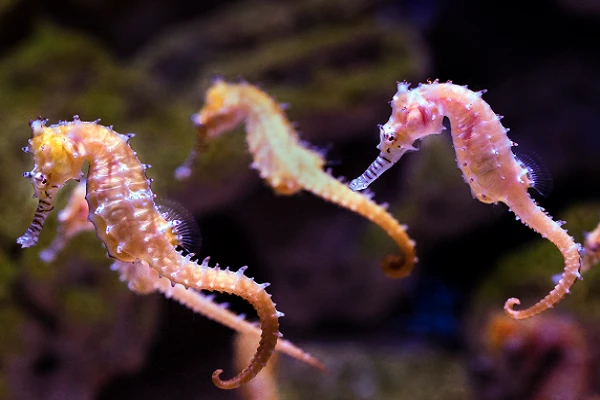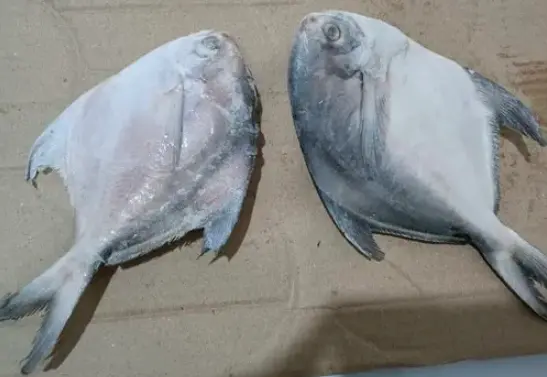Seahorses are little marine fishes having a place with the family Hippocampus. Seahorses can be tracked down in a shallow calm and tropical salt waters. The various seahorse species range in size from 0.6 creeps to 14 inches. They have twisted necks, unique trunks, tails, and long-snouted heads.
Despite the fact that they are bony and hard fishes, seahorses don’t have scales. Their hard plates are covered by flimsy skin. The seahorses swim upstanding, and they move themselves utilizing their dorsal fins.

These marine fishes don’t have teeth; thusly they will more often than not suck in their prey and swallow them. Seahorses feed on the little shellfish, similar to copepods and shrimps, which creep at the lower part of the sea or the ones drifting in the water. Most seahorses love mysid shrimps, yet others consume various sorts of spineless creatures, tiny fishes, and larval fishes.
What Foods Do Seahorses Eat?
Seahorses eat shellfish, phytoplankton, zooplankton, and algae. These fish are omnivores that utilize their nose to eat food. Seahorses have extraordinary physiology that expects them to eat frequently but in limited quantities.
The food varieties that seahorses are probably going to eat include:
- Krill
- Ocean snails
- Zooplankton
- Phytoplankton.
- Algae
- Mysis shrimp
- Caridean shrimp
- Caprellidae
- Amphipods
- Copepod
- Rotifers
- Cleaner shrimp.
- Daphnia
- Brine shrimp
- Ghost shrimp
- Red shrimp
- Grass shrimp
- Guppies
- Glass shrimp.
It is essential to remember that seahorses are tiny fish, and the animals they eat are a lot more modest than them. The saltwater shrimp and ocean snails polished off by the seahorse are not exactly around 50% of an inch long, and their hatchlings are much more modest.

How Often Do The Seahorses Eat?
Since they are slow swimmers, eating can be a huge challenge. Seahorses don’t have stomachs; in this way, they need to eat routinely since their food goes directly to their digestive frameworks. The young ones eat around 3,000 bits of food day to day. Grown-up seahorses are continuously brushing and can eat up to multiple times consistently.
How Do The Seahorses Get Their Food?
Seahorses are bad swimmers; in this manner, they will more often than not anchor themselves to corals or ocean growth utilizing their prehensile tails. The seahorses have exceptional neck that is adjusted to get all the moving prey. They can move quietly and gradually up to where their prey is without alarming them. When they are in short proximity, they can turn their heads and bring their noses near the prey just prior to slurping them.
They have three stages of feeding (recuperation, expansive, and preliminary). During the preliminary stage, they gradually approach their prey, and when they are near them, they flex their heads ventrally. During the expansive stage, they catch their prey by extending their buccal hole, lifting their heads, and sucking them into their mouth. After they have gulped the food, the hyoid device, head, and jaw return to their unique position.
The presence of vegetative cover impacts their eating ways of behaving. At the point when they are in regions with little vegetative covers, the seahorses will quite often sit and hang tight for the prey. In places with broad vegetation, they assess their environmental factors and even feed while swimming.
What is the quantity of food that seahorses eat?
The seahorse is a generally little creature, with the biggest assortment of them being around 12 inches long and the littlest of them being under 1 inch long. They are likewise among the slowest fish in the sea, so it would make sense that they don’t need a ton of food.
However, the seahorse doesn’t have a stomach inside its digestive system, meaning it should continually eat food to keep up with its energy levels.
Seahorses should eat frequently. By and large, they need to eat somewhere in the range of 30 and 50 times each day. Albeit the sum that seahorses eat is generally little, the reality stays that their successive dietary patterns require a decent measure of hunting to keep their dietary necessities met.
How Do Seahorses Hunt Food?
Seahorses are extremely sluggish swimmers, and they are not exceptionally enormous fish, so hunting could appear to be exceedingly difficult for them. Be that as it may, they are adroit at satisfying their food necessities.
Everything begins with their astonishing feeling of sight that they use to distinguish decision food sources that suit their dietary requirements. They can follow little scavengers that lack senses to keep away from them and afterward grab them into their mouths utilizing a vacuum force in their nose.
They would make for good trackers notwithstanding their unfortunate versatility. Thusly, seahorses adopt one more strategy to finding the food they need. They utilize their prehensile tails to grasp onto a steady anchor point like coral or one more type of disguise like vegetation. A short time later, they trust that food will drift by prior to ambushing it and eating it.
The state of their head helps while they leap out at prey, empowering these generally sluggish animals to guarantee a feast. The seahorse is definitely not an inconceivably sly hunter, however, they are evidently extremely compelling on the grounds that a large number of them eat a few dozen little shrimp every day.
What Predators make seahorses their prey?
As we have said, seahorses have many elements neutralizing them in the sea. They are among the slowest fish in the sea, they have no safeguarding strategies against genuine hunters, and in the event that they get found out beyond cover, they are not difficult to take out.
One thing they have working for them is their capacity to cover themselves. They can utilize their shape, size, and variety to mix out of the spotlight and protect themselves from any hunters, particularly those that depend upon their sight to chase.
By the by, seahorses are a simple feast for hunters, even ones that are not so aggressive. All things considered, it’s normal for seahorses to succumb to a wide assortment of animals, including:
- Crabs
- Bluefin fish
- Sharks
- Rays
- Tigerfish
- Penguins
- Different predatory fish.
- People.
This multitude of animals is preferable adjusted to go after over seahorses are to guard. As we’ve previously referenced, by far most seahorses are killed as adolescents, yet many are as yet killed as grown-ups.
Seahorses are delightful animals that are difficult to botch in the sea. They have a wide reach all over the planet, carrying them into contact with many sorts of other fish, scavengers, and different food sources.
Seahorses are little fish that have enormous cravings due to their digestive framework, so they’re at the same time the absolute smallest fish yet additionally the most constant eaters.

![50+ Fish Names In Tamil With Pictures [English Tamil Fish Names] Fish Names In Tamil With Pictures](https://thefishblog.com/wp-content/uploads/2022/08/Fish-Names-in-Tamil-150x150.webp)





